Paper Menu >>
Journal Menu >>
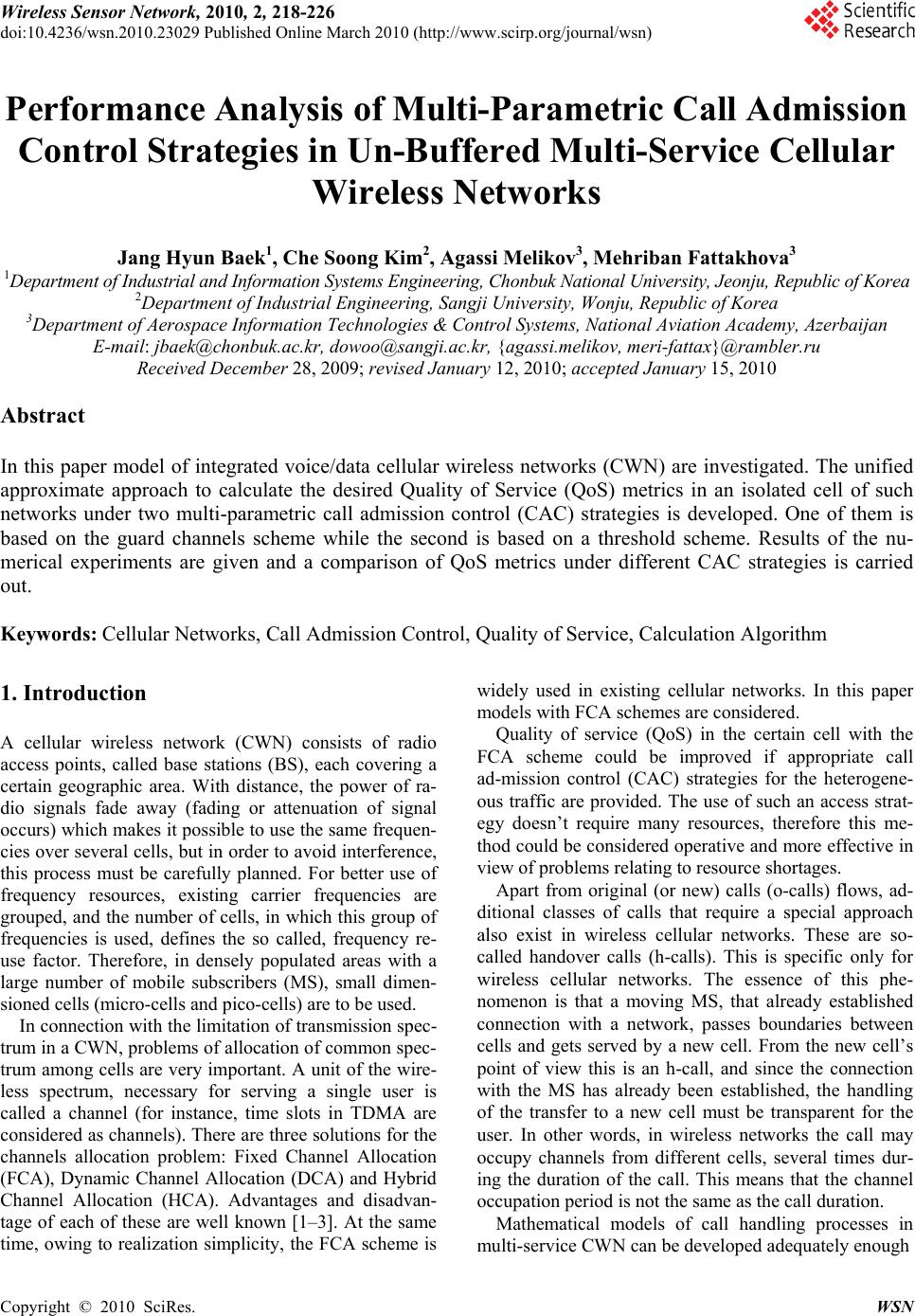 Wireless Sensor Network, 2010, 2, 218-226 doi:10.4236/wsn.2010.23029 Published Online March 2010 (http://www.scirp.org/journal/wsn) Copyright © 2010 SciRes. WSN Performance Analysis of Multi-Parametric Call Admission Control Strategies in Un-Buffered Multi-Service Cellular Wireless Networks Jang Hyun Baek1, Che Soong Kim2, Agassi Melikov3, Mehriban Fattakhova3 1Department of Industrial and Information Systems Engineering, Chonbuk National University, Jeonju, Republic of Korea 2Department of Industrial Engineering, Sangji University, Wonju, Republic of Korea 3Department of Aerospace Information Technologies & Control Systems, National Aviation Academy, Azerbaijan E-mail: jbaek@chonbuk.ac.kr, dowoo@sangji.ac.kr, {agassi.melikov, meri-fattax}@rambler.ru Received December 28, 2009; revised January 12, 2010; accepted January 15, 2010 Abstract In this paper model of integrated voice/data cellular wireless networks (CWN) are investigated. The unified approximate approach to calculate the desired Quality of Service (QoS) metrics in an isolated cell of such networks under two multi-parametric call admission control (CAC) strategies is developed. One of them is based on the guard channels scheme while the second is based on a threshold scheme. Results of the nu- merical experiments are given and a comparison of QoS metrics under different CAC strategies is carried out. Keywords: Cellular Networks, Call Admission Control, Quality of Service, Calculation Algorithm 1. Introduction A cellular wireless network (CWN) consists of radio access points, called base stations (BS), each covering a certain geographic area. With distance, the power of ra- dio signals fade away (fading or attenuation of signal occurs) which makes it possible to use the same frequen- cies over several cells, but in order to avoid interference, this process must be carefully planned. For better use of frequency resources, existing carrier frequencies are grouped, and the number of cells, in which this group of frequencies is used, defines the so called, frequency re- use factor. Therefore, in densely populated areas with a large number of mobile subscribers (MS), small dimen- sioned cells (micro-cells and pico-cells) are to be used. In connection with the limitation of transmission spec- trum in a CWN, problems of allocation of common spec- trum among cells are very important. A unit of the wire- less spectrum, necessary for serving a single user is called a channel (for instance, time slots in TDMA are considered as channels). There are three solutions for the channels allocation problem: Fixed Channel Allocation (FCA), Dynamic Channel Allocation (DCA) and Hybrid Channel Allocation (HCA). Advantages and disadvan- tage of each of these are well known [1–3]. At the same time, owing to realization simplicity, the FCA scheme is widely used in existing cellular networks. In this paper models with FCA schemes are considered. Quality of service (QoS) in the certain cell with the FCA scheme could be improved if appropriate call ad-mission control (CAC) strategies for the heterogene- ous traffic are provided. The use of such an access strat- egy doesn’t require many resources, therefore this me- thod could be considered operative and more effective in view of problems relating to resource shortages. Apart from original (or new) calls (o-calls) flows, ad- ditional classes of calls that require a special approach also exist in wireless cellular networks. These are so- called handover calls (h-calls). This is specific only for wireless cellular networks. The essence of this phe- nomenon is that a moving MS, that already established connection with a network, passes boundaries between cells and gets served by a new cell. From the new cell’s point of view this is an h-call, and since the connection with the MS has already been established, the handling of the transfer to a new cell must be transparent for the user. In other words, in wireless networks the call may occupy channels from different cells, several times dur- ing the duration of the call. This means that the channel occupation period is not the same as the call duration. Mathematical models of call handling processes in multi-service CWN can be developed adequately enough 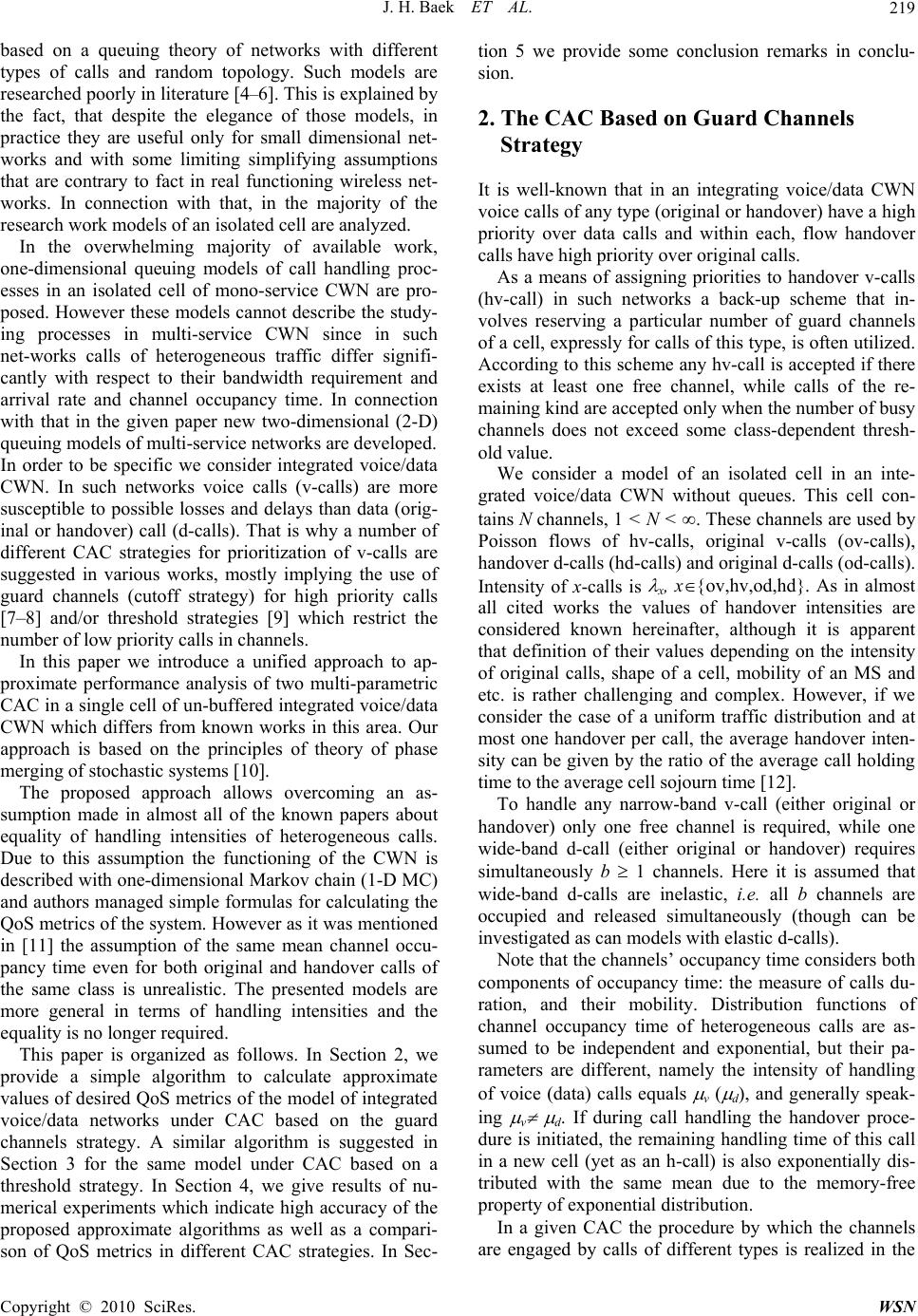 J. H. Baek ET AL.219 based on a queuing theory of networks with different types of calls and random topology. Such models are researched poorly in literature [4–6]. This is explained by the fact, that despite the elegance of those models, in practice they are useful only for small dimensional net- works and with some limiting simplifying assumptions that are contrary to fact in real functioning wireless net- works. In connection with that, in the majority of the research work models of an isolated cell are analyzed. In the overwhelming majority of available work, one-dimensional queuing models of call handling proc- esses in an isolated cell of mono-service CWN are pro- posed. However these models cannot describe the study- ing processes in multi-service CWN since in such net-works calls of heterogeneous traffic differ signifi- cantly with respect to their bandwidth requirement and arrival rate and channel occupancy time. In connection with that in the given paper new two-dimensional (2-D) queuing models of multi-service networks are developed. In order to be specific we consider integrated voice/data CWN. In such networks voice calls (v-calls) are more susceptible to possible losses and delays than data (orig- inal or handover) call (d-calls). That is why a number of different CAC strategies for prioritization of v-calls are suggested in various works, mostly implying the use of guard channels (cutoff strategy) for high priority calls [7–8] and/or threshold strategies [9] which restrict the number of low priority calls in channels. In this paper we introduce a unified approach to ap- proximate performance analysis of two multi-parametric CAC in a single cell of un-buffered integrated voice/data CWN which differs from known works in this area. Our approach is based on the principles of theory of phase merging of stochastic systems [10]. The proposed approach allows overcoming an as- sumption made in almost all of the known papers about equality of handling intensities of heterogeneous calls. Due to this assumption the functioning of the CWN is described with one-dimensional Markov chain (1-D MC) and authors managed simple formulas for calculating the QoS metrics of the system. However as it was mentioned in [11] the assumption of the same mean channel occu- pancy time even for both original and handover calls of the same class is unrealistic. The presented models are more general in terms of handling intensities and the equality is no longer required. This paper is organized as follows. In Section 2, we provide a simple algorithm to calculate approximate values of desired QoS metrics of the model of integrated voice/data networks under CAC based on the guard channels strategy. A similar algorithm is suggested in Section 3 for the same model under CAC based on a threshold strategy. In Section 4, we give results of nu- merical experiments which indicate high accuracy of the proposed approximate algorithms as well as a compari- son of QoS metrics in different CAC strategies. In Sec- tion 5 we provide some conclusion remarks in conclu- sion. 2. The CAC Based on Guard Channels Strategy It is well-known that in an integrating voice/data CWN voice calls of any type (original or handover) have a high priority over data calls and within each, flow handover calls have high priority over original calls. As a means of assigning priorities to handover v-calls (hv-call) in such networks a back-up scheme that in- volves reserving a particular number of guard channels of a cell, expressly for calls of this type, is often utilized. According to this scheme any hv-call is accepted if there exists at least one free channel, while calls of the re- maining kind are accepted only when the number of busy channels does not exceed some class-dependent thresh- old value. We consider a model of an isolated cell in an inte- grated voice/data CWN without queues. This cell con- tains N channels, 1 < N < . These channels are used by Poisson flows of hv-calls, original v-calls (ov-calls), handover d-calls (hd-calls) and original d-calls (od-calls). Intensity of x-calls is x, xov,hv,od,hd. As in almost all cited works the values of handover intensities are considered known hereinafter, although it is apparent that definition of their values depending on the intensity of original calls, shape of a cell, mobility of an MS and etc. is rather challenging and complex. However, if we consider the case of a uniform traffic distribution and at most one handover per call, the average handover inten- sity can be given by the ratio of the average call holding time to the average cell sojourn time [12]. To handle any narrow-band v-call (either original or handover) only one free channel is required, while one wide-band d-call (either original or handover) requires simultaneously b 1 channels. Here it is assumed that wide-band d-calls are inelastic, i.e. all b channels are occupied and released simultaneously (though can be investigated as can models with elastic d-calls). Note that the channels’ occupancy time considers both components of occupancy time: the measure of calls du- ration, and their mobility. Distribution functions of channel occupancy time of heterogeneous calls are as- sumed to be independent and exponential, but their pa- rameters are different, namely the intensity of handling of voice (data) calls equals v ( d), and generally speak- ing v d. If during call handling the handover proce- dure is initiated, the remaining handling time of this call in a new cell (yet as an h-call) is also exponentially dis- tributed with the same mean due to the memory-free property of exponential distribution. In a given CAC the procedure by which the channels are engaged by calls of different types is realized in the Copyright © 2010 SciRes. WSN 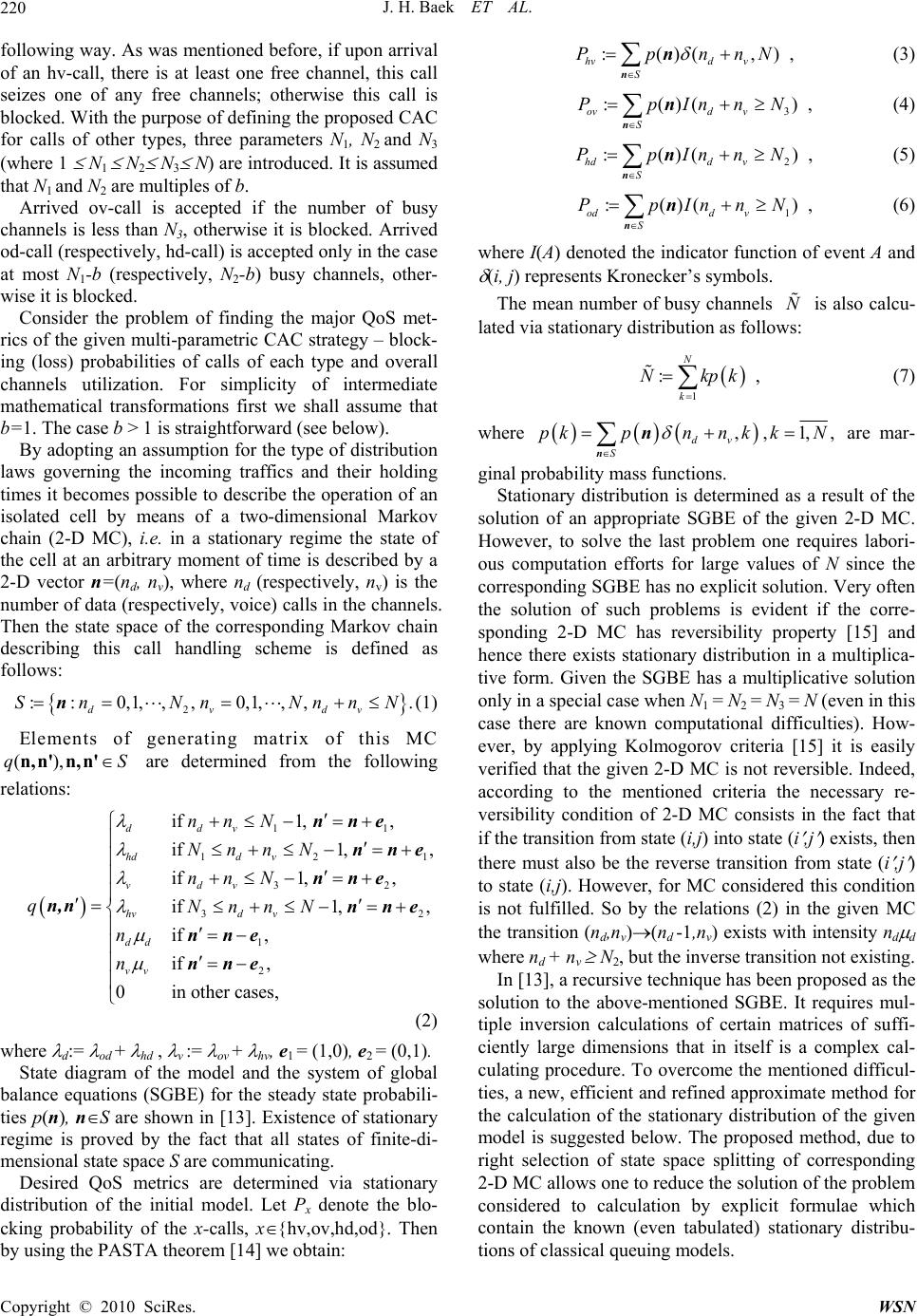 J. H. Baek ET AL. 220 . S 1 2 ,:()( ,) hvd v S PpnnN n n (3) following way. As was mentioned before, if upon arrival of an hv-call, there is at least one free channel, this call seizes one of any free channels; otherwise this call is blocked. With the purpose of defining the proposed CAC for calls of other types, three parameters N1, N2 and N3 (where 1 N1 N2 N3 N) are introduced. It is assumed that N1 and N2 are multiples of b. 3 :()( ) ovd v S PpInnN , n n (4) 2 :()( ) hdd v S PpInnN , n n (5) 1 :()( ) odd v S PpInnN , n n (6) Arrived ov-call is accepted if the number of busy channels is less than N3, otherwise it is blocked. Arrived od-call (respectively, hd-call) is accepted only in the case at most N1-b (respectively, N2-b) busy channels, other- wise it is blocked. where I(A) denoted the indicator function of event А and (i, j) represents Kronecker’s symbols. The mean number of busy channels is also calcu- lated via stationary distribution as follows: N Consider the problem of finding the major QoS met- rics of the given multi-parametric CAC strategy – block- ing (loss) probabilities of calls of each type and overall channels utilization. For simplicity of intermediate mathematical transformations first we shall assume that b=1. The case b > 1 is straightforward (see below). 1 : N k Nkpk , (7) where ,, 1, dv S pkpnn kkN , n n are mar- ginal probability mass functions. By adopting an assumption for the type of distribution laws governing the incoming traffics and their holding times it becomes possible to describe the operation of an isolated cell by means of a two-dimensional Markov chain (2-D MC), i.e. in a stationary regime the state of the cell at an arbitrary moment of time is described by a 2-D vector n=(nd, nv), where nd (respectively, nv) is the number of data (respectively, voice) calls in the channels. Then the state space of the corresponding Markov chain describing this call handling scheme is defined as follows: 2 ::0,1,,, 0,1,,, dvdv SnNnNnnN n(1) Elements of generating matrix of this MC are determined from the following relations: (),qn,n' n,n' 11 12 32 3 1 2 if 1,, if 1,, if 1,, if 1,, if , if , 0in other cases, ddv hdd v vdv hvd v dd vv nnN Nnn N nnN qNnnN n n nne nne nne n,n nne nne nne (2) Stationary distribution is determined as a result of the solution of an appropriate SGBE of the given 2-D MC. However, to solve the last problem one requires labori- ous computation efforts for large values of N since the corresponding SGBE has no explicit solution. Very often the solution of such problems is evident if the corre- sponding 2-D MC has reversibility property [15] and hence there exists stationary distribution in a multiplica- tive form. Given the SGBE has a multiplicative solution only in a special case when N1 = N2 = N3 = N (even in this case there are known computational difficulties). How- ever, by applying Kolmogorov criteria [15] it is easily verified that the given 2-D MC is not reversible. Indeed, according to the mentioned criteria the necessary re- versibility condition of 2-D MC consists in the fact that if the transition from state (i,j) into state (i ,j ) exists, then there must also be the reverse transition from state (i ,j ) to state (i,j). However, for MC considered this condition is not fulfilled. So by the relations (2) in the given MC the transition (nd,nv)(nd -1,nv) exists with intensity nd d where nd + nv N2, but the inverse transition not existing. In [13], a recursive technique has been proposed as the solution to the above-mentioned SGBE. It requires mul- tiple inversion calculations of certain matrices of suffi- ciently large dimensions that in itself is a complex cal- culating procedure. To overcome the mentioned difficul- ties, a new, efficient and refined approximate method for the calculation of the stationary distribution of the given model is suggested below. The proposed method, due to right selection of state space splitting of corresponding 2-D MC allows one to reduce the solution of the problem considered to calculation by explicit formulae which contain the known (even tabulated) stationary distribu- tions of classical queuing models. where d:= od + hd , v := ov + hv, e1 = (1,0), e2 = (0,1). State diagram of the model and the system of global balance equations (SGBE) for the steady state probabili- ties p(n), nS are shown in [13]. Existence of stationary regime is proved by the fact that all states of finite-di- mensional state space S are communicating. Desired QoS metrics are determined via stationary distribution of the initial model. Let Px denote the blo- cking probability of the x-calls, xhv,ov,hd,od. Then by using the PASTA theorem [14] we obtain: Copyright © 2010 SciRes. WSN 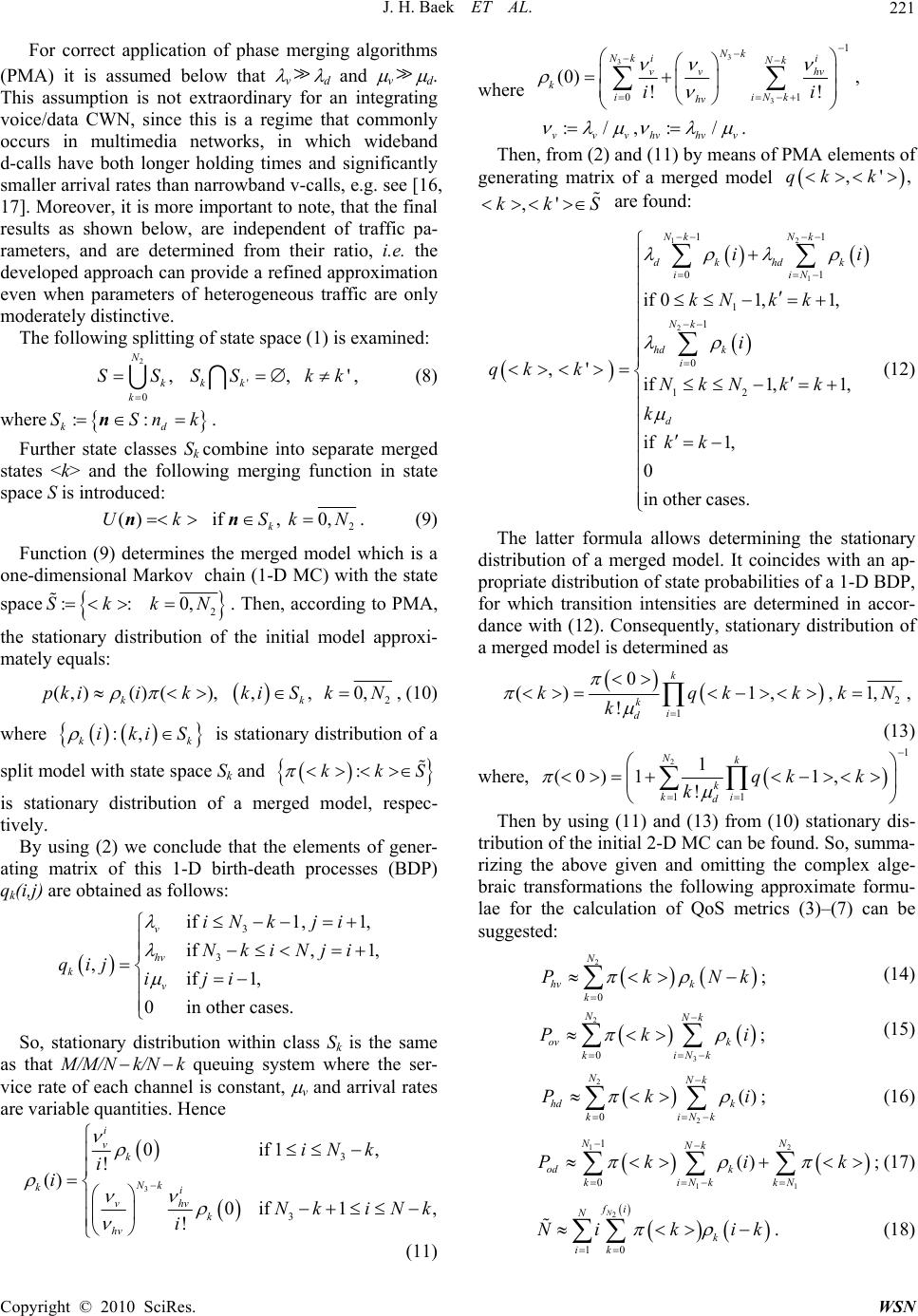 J. H. Baek ET AL.221 k k For correct application of phase merging algorithms (PMA) it is assumed below thatv d and v d. This assumption is not extraordinary for an integrating voice/data CWN, since this is a regime that commonly occurs in multimedia networks, in which wideband d-calls have both longer holding times and significantly smaller arrival rates than narrowband v-calls, e.g. see [16, 17]. Moreover, it is more important to note, that the final results as shown below, are independent of traffic pa- rameters, and are determined from their ratio, i.e. the developed approach can provide a refined approximation even when parameters of heterogeneous traffic are only moderately distinctive. The following splitting of state space (1) is examined: 2 ' 0 , , ' N kkk k SSSS k , (8) where . :: kd SSn n Further state classes Sk combine into separate merged states <k> and the following merging function in state space S is introduced: 2 () if , 0,. k Uk SkN nn (9) Function (9) determines the merged model which is a one-dimensional Markov chain (1-D MC) with the state space 2 :: 0,SkkN . Then, according to PMA, the stationary distribution of the initial model approxi- mately equals: 2 (,)()(), ,, 0,, kk pkiikkiSkN (10) where is stationary distribution of a split model with state space Sk and :, k ikiS k :kkS is stationary distribution of a merged model, respec- tively. By using (2) we conclude that the elements of gener- ating matrix of this 1-D birth-death processes (BDP) qk(i,j) are obtained as follows: 3 3 if 1,1, if ,1, ,if 1, 0in other cases. v hv k v iN kji NkiNji qij iji So, stationary distribution within class Sk is the same as that M/M/N k/N k queuing system where the ser- vice rate of each channel is constant, v and arrival rates are variable quantities. Hence 3 3 3 0if 1, ! () 0if 1 ! i v k Nk ki vhv k hv iN k i i Nk iNk i where 3 3 3 1 01 (0) , !! :/,: /. Nk ii Nk Nk vv hv k iiNk hv vvvhv hvv ii Then, from (2) and (11) by means of PMA elements of generating matrix of a merged model ,'qk k , S ,'kk are found: 12 1 2 11 01 1 1 0 12 if 01,1, ,' if 1,1, if 1, 0 in other cases. NkN k dkhd k iiN Nk hd k i d ii kNk k i qk kNkN kk k kk (12) The latter formula allows determining the stationary distribution of a merged model. It coincides with an ap- propriate distribution of state probabilities of a 1-D BDP, for which transition intensities are determined in accor- dance with (12). Consequently, stationary distribution of a merged model is determined as 2 1 0 ()1, ,1, ! k k i d kqkkk k,N (13) where, 2 1 11 1 (0) 11, ! Nk k ki d qk k k Then by using (11) and (13) from (10) stationary dis- tribution of the initial 2-D MC can be found. So, summa- rizing the above given and omitting the complex alge- braic transformations the following approximate formu- lae for the calculation of QoS metrics (3)–(7) can be suggested: 2 0 ; N hv k k PkN k (14) 2 3 0 ; NNk ov k kiNk Pk i i (15) 2 2 0 (); NNk hd k kiNk Pk (16) , (11) 12 11 1 0 () ; NN Nk od k kiNkkN Pkik (17) 2 10 N fi N k ik Nik ik . (18) Copyright © 2010 SciRes. WSN  J. H. Baek ET AL. 222 22 :()(,) , hdddvd SnS PpnRpnnNInR , n nn (22) Hereinafter if 1, if . k x xk fx kkiN Now we can develop the algorithm to calculate the QoS metrics of the investigated multi-parametric CAC for the similar model with wide-band d-calls (due to the limited volume of work this algorithm does not present here). 11 :()( ), oddd vd SnS PpInRpnnNInR . n nn (23) Unlike the CAC based on the guard channel strategy, it is easy to see that under this one there is no circulation flow in the state diagram of the underlying 2-D MC, i.e., reversible [15]. In other words, there is a general solution to the system of local balance equations (SLBE) in this chain. Therefore, by choosing any path between these states in the state diagram, we can express any state probability p(nd,nv) using the state probability p(0,0). So, in case R2+R3 N we get the following multiplicative solution for stationary distribution of the underlying 2-D MC: 3. The CAC Based on Threshold Strategy Now we consider an alternative CAC in the integrated voice/data networks which is based on a threshold strat- egy. A more detailed description of the given CAC, fol- lows. As in the CAC based on guard channels, we as- sume that an arrived hv-call is accepted as long as at least one free channel is available; otherwise it is blocked. For the purpose of definition of CAC based on a thresh- old strategy for calls of other types, three parameters R1, R2 and R3, where 1 R 1 R 2 R 3 N are introduced. Then the proposed CAC defines the following rules for admission of heterogeneous calls: an od-call (respec- tively, hd-call and ov-call) is accepted only if the number of calls of the given type in progress is less than R1 (re- spectively, R2 and R3) and a free channel is available; otherwise it is blocked. For the sake of simplicity we shall assume that b=1. The case b > 1 is straightforward (see Section 2). The state of the system under the given CAC at any time is also described by 2-D vector n = (nd, nv), where nd (re- spectively, nv) is the number of data (respectively, voice) calls in the channels. Then state space of appropriate 2-D MC is given by: 2 :: 0,,0,; dvdv SnRnNnnN n 3 1 13 13 13 123 0, 0, !! if ,, 0, 0, !! if ,, , 0, 0, !! if ,, 0, 0, !! dv dv dv dv nn dv dv dv R nn dhvv dvhv dv dv R nn hd vd dv hd dv RR nn hd hvdv d vhdhv p nn nRnR p nn nRRnN pn n p nn RnRn R p nn 123 if ,, dv RnRRn N (24) . 1 , (19) where p(0,0) is determined from normalizing condition, The elements of generating matrix of the appropriate 2-D MC in this case is determined as follows: 11 12 32 32 1 2 if 1,, if 1,, if 1,, if 1,, if , if , 0in other cases. dd hd d vv hv v dd vv nR Rn R nR qRnN n n nne nne nne n,n nne nne nne (20) 31 12 1 32 1 3 (0,0) !! !! !! dv dv dv dv ! R R nn nn dvvdhv d nS nS dv hvdvhd RR nn nn hd vdvhd hv nT nS dvhdhvd v pnn nn nn nn Here we use the following notations: d: = d/ d, hd: = hd/ d; 2 113 213 31 3 4123 ::,, ::,1 , ::1 ,, ::1 ,1 dv dv dv dv SSnRnR SSnRRnN SSRnRnR SSRnRRn n n n n Blocking probability of hv-calls and the mean number of busy channels are defined similarly to (3) and (7), respectively. The other QoS metrics are defined as the following marginal distributions of initial chain: .N In the case R2 + R3 > N stationary distribution has the following form: 3 :()( ) ov v S PpInR n n (21) Copyright © 2010 SciRes. WSN 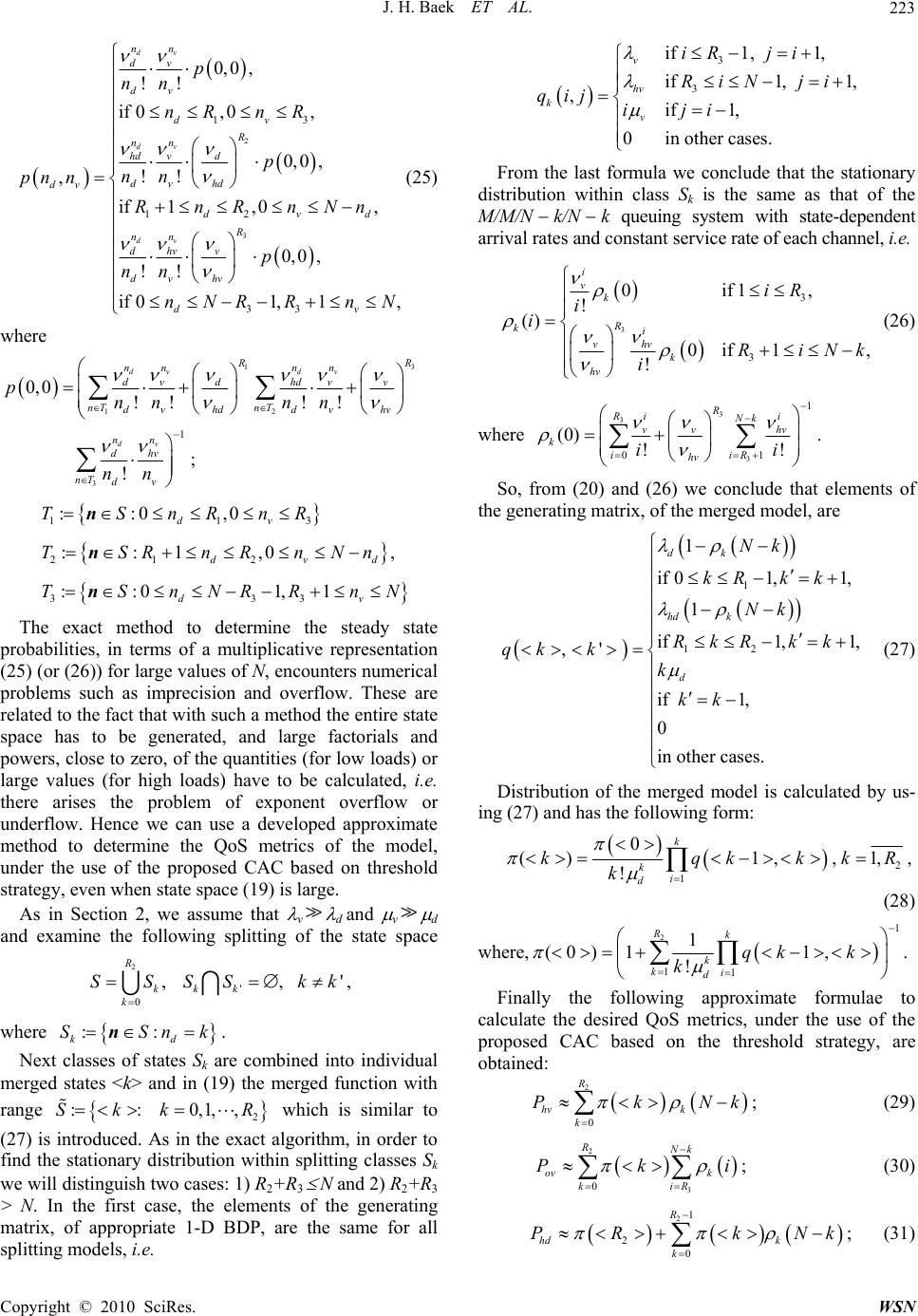 J. H. Baek ET AL.223 2 3 13 12 33 0, 0, !! if 0,0, 0, 0, !! , if 1,0, 0, 0, !! if 01,1, dv dv dv nn dv dv dv R nn hd vd dv hd dv dvd R nn dhv v dv hv dv p nn nR nR p nn pn n RnRnNn p nn nNR RnN (25) where 13 12 3 1 0, 0!! !! ; ! dv dv dv R R nn nn dv dhdvv nT nT dvhddvhv nn dhv nT dv pnn nn nn 11 ::0 ,0 dv TSnRn n 3 R , d N k k 212 ::1 ,0 dv TSRnRnNnn 333 ::0 1,1 dv TSnNRRn n The exact method to determine the steady state probabilities, in terms of a multiplicative representation (25) (or (26)) for large values of N, encounters numerical problems such as imprecision and overflow. These are related to the fact that with such a method the entire state space has to be generated, and large factorials and powers, close to zero, of the quantities (for low loads) or large values (for high loads) have to be calculated, i.e. there arises the problem of exponent overflow or underflow. Hence we can use a developed approximate method to determine the QoS metrics of the model, under the use of the proposed CAC based on threshold strategy, even when state space (19) is large. As in Section 2, we assume that v d and v d and examine the following splitting of the state space 2 ' 0 , , ' R kkk k SSSSk , where . :: kd SSn n Next classes of states Sk are combined into individual merged states <k> and in (19) the merged function with range which is similar to (27) is introduced. As in the exact algorithm, in order to find the stationary distribution within splitting classes Sk we will distinguish two cases: 1) R2+R3 N and 2) R2+R3 > N. In the first case, the elements of the generating matrix, of appropriate 1-D BDP, are the same for all splitting models, i.e. 2 :: 0,1,,Skk R 3 3 if 1,1, if 1,1, ,if 1, 0in other cases. v hv k v iR ji RiN ji qij iji From the last formula we conclude that the stationary distribution within class Sk is the same as that of the M/M/N k/N k queuing system with state-dependent arrival rates and constant service rate of each channel, i.e. 3 3 3 0if 1, ! () 0if 1 ! i v k R ki vhv k hv iR i i RiN i ,k (26) where 3 3 3 1 01 (0) . !! R ii RNk vv hv k iiR hv ii So, from (20) and (26) we conclude that elements of the generating matrix, of the merged model, are 1 12 1 if 01,1, 1 if 1,1, ,' if 1, 0 in other cases. dk hd k d Nk kRk k Nk RkR kk qkk k kk (27) Distribution of the merged model is calculated by us- ing (27) and has the following form: 2 1 0 ()1, ,1, ! k k i d kqkkk k ,R (28) where, 2 1 11 1 (0) 11, ! Rk k ki d qk k k . Finally the following approximate formulae to calculate the desired QoS metrics, under the use of the proposed CAC based on the threshold strategy, are obtained: 2 0 ; R hv k k PkN k i k (29) 2 3 0 ; RNk ov k kiR Pk (30) 21 2 0 ; R hd k k PR kN (31) Copyright © 2010 SciRes. WSN 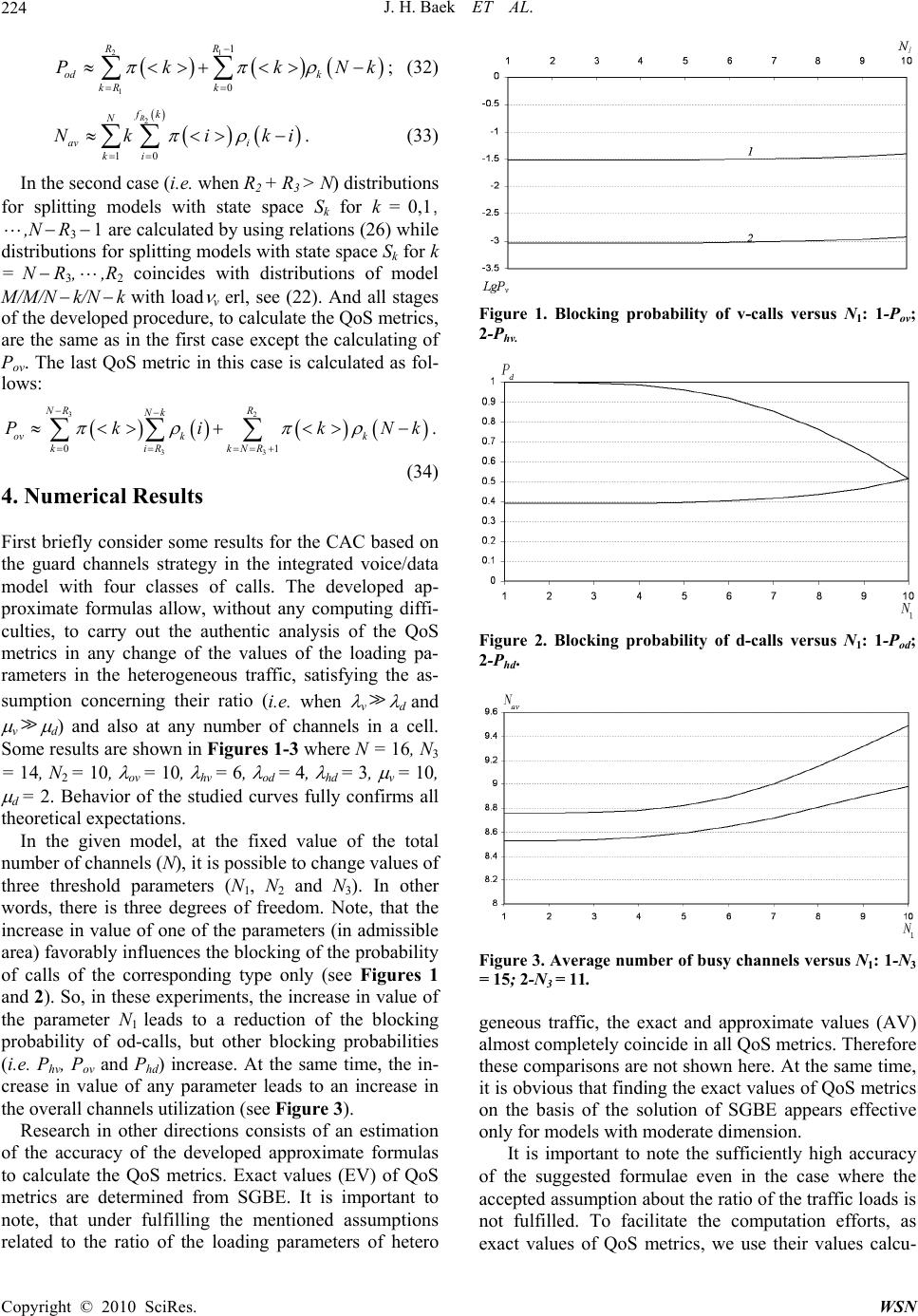 J. H. Baek ET AL. 224 k 21 1 1 0 ; RR od k kR k Pk kN (32) 2 10 . R fk N av i ki Nk ik i k (33) In the second case (i.e. when R2 + R3 > N) distributions for splitting models with state space Sk for k = 0,1, ,N R31 are calculated by using relations (26) while distributions for splitting models with state space Sk for k = N R3,,R2 coincides with distributions of model M/M/N k/N k with load v erl, see (22). And all stages of the developed procedure, to calculate the QoS metrics, are the same as in the first case except the calculating of Pov. The last QoS metric in this case is calculated as fol- lows: 32 33 01 . NR R Nk ov kk kiRkNR PkikN (34) 4. Numerical Results First briefly consider some results for the CAC based on the guard channels strategy in the integrated voice/data model with four classes of calls. The developed ap- proximate formulas allow, without any computing diffi- culties, to carry out the authentic analysis of the QoS metrics in any change of the values of the loading pa- rameters in the heterogeneous traffic, satisfying the as- sumption concerning their ratio (i.e. when v d and v d) and also at any number of channels in a cell. Some results are shown in Figures 1-3 where N = 16, N3 = 14, N2 = 10, ov = 10 , hv = 6, od = 4, hd = 3, v = 10, d = 2. Behavior of the studied curves fully confirms all theoretical expectations. In the given model, at the fixed value of the total number of channels (N), it is possible to change values of three threshold parameters (N1, N 2 and N3). In other words, there is three degrees of freedom. Note, that the increase in value of one of the parameters (in admissible area) favorably influences the blocking of the probability of calls of the corresponding type only (see Figures 1 and 2). So, in these experiments, the increase in value of the parameter N1 leads to a reduction of the blocking probability of od-calls, but other blocking probabilities (i.e. Phv, Pov and Phd) increase. At the same time, the in- crease in value of any parameter leads to an increase in the overall channels utilization (see Figure 3). Research in other directions consists of an estimation of the accuracy of the developed approximate formulas to calculate the QoS metrics. Exact values (EV) of QoS metrics are determined from SGBE. It is important to note, that under fulfilling the mentioned assumptions related to the ratio of the loading parameters of hetero Figure 1. Blocking probability of v-calls versus N1: 1-Pov; 2-Phv. Figure 2. Blocking probability of d-calls versus N1: 1-Pod; 2-Phd. Figure 3. Average number of busy channels versus N1: 1-N3 = 15; 2-N3 = 11. geneous traffic, the exact and approximate values (AV) almost completely coincide in all QoS metrics. Therefore these comparisons are not shown here. At the same time, it is obvious that finding the exact values of QoS metrics on the basis of the solution of SGBE appears effective only for models with moderate dimension. It is important to note the sufficiently high accuracy of the suggested formulae even in the case where the accepted assumption about the ratio of the traffic loads is not fulfilled. To facilitate the computation efforts, as exact values of QoS metrics, we use their values calcu- Copyright © 2010 SciRes. WSN  J. H. Baek ET AL.225 lated from explicit formulas, see [21]. In mentioned work, appropriate results are obtained in the special case b = 1 and v = d. Let's note, that condition v = d contradicts our assumption v d. Highest accuracy of the devel- oped approximate formulas is observed at the calculation of the QoS metric for v-calls, since the maximal differ- ence between exact and approximate values does not exceed 0.001. Small deviations take place in the calcula- tion of the QoS metrics for d-calls, but also thus in the worst case scenario the absolute error of the proposed formulas does not exceed 0.09, that are quite compre- hensible in an engineering practice. Similar results are observed for an average number of occupied channels of a cell. It is important to note, that numerous numerical experiments have shown, that at all admissible loads, the accuracy of the proposed approximate formulas grows with the increase in the value of the total number of channels. It is clear that in terms of simplicity and effi- ciency, the proposed approach is emphatically superior to the approach based on the use of balance equations to calculate the QoS metrics of the given CAC in the model with a non-identical channel occupancy time. Also note, that high accuracy in the calculation of the QoS metrics for v-calls is observed even at those load- ings which do not satisfy any of the accepted assump- tions above concerning the ratio of intensities of hetero- geneous traffic. So, for example, at the same values of number of channels and parameters of strategy, at ov = 4, hv = 3, od = 10, hd = 6, v = d = 2 (i.e. when assump- tions v d, v d are not fulfilled) the absolute error for the mentioned QoS metric does not exceed 0.002. Similar results are observed for an average number of occupied channels of a cell. However, the proposed ap- proximate formulas show low accuracy for d-calls since for them the maximal absolute error exceeds 0.2. Numerical experiments with the CAC based on the threshold strategy are carried out also. Due to the limited volume of work these results are not presented here. As in CAC based on guard channels, the increase in value of one of the parameters (in admissible area), favorably affect the blocking probability of calls of the corre- sponding type only. So, the increase in value of parame- ter R1 leads to a reduction of the blocking probability of od-calls but other blocking probabilities (i.e. Phv, Pov and Phd) increase. At the same time, the increase in the value of any parameter leads to an increase in the overall channels utilization. At the end of this section we conducted research on comparative analysis of QoS metrics of two schemes: CAC based on the guard channels scheme and the CAC based on the threshold strategy. Comparison was done in the broad range of the number of channels and load pa- rameters. In each access strategy the total number of channels is fixed and controllable parameters are N1, N2, N3 (for CAC based on the guard channels scheme) and R1, R2, R 3 (for CAC based on the threshold strategy). As mentioned above, the behavior of the QoS metrics, with respect to the indicated controllable parameters, in dif- ferent CAC, are the same. It is important to note that with the given number of channels, loads and QoS requirements in either of the CAC strategies may or may not meet the requirements. For instance, in the model of mono-service CWN for the given values of N = 100, o = 50 erl, h = 35 erl follow- ing requirements Po 0.1, Ph 0.007 and80N ~ are not met with CAC based on guard channels irrespective of the value of the parameter g (number of guard channels), whereas CAC based on individual pool only for h-calls (i.e. ro = 0) meets the requirements at rh = 40. However, for the same given initial data, requirements Po 0.3, Ph 0.0001 andare only met by CAC based on the guard channel scheme at g = 20, and never met by CAC based on the individual pool strategy irrespective of the value of its parameter rh. Thus it is possible to find the optimal strategy (in a given context) at the given loads without changing the number of channels. 60 ~N Apparently, both strategies have the same implemen- tation complexity. That is why the selection of either of them, at each particular case, must be based on the an- swer to the following question: does it meet the given QoS requirements? These issues are a subject to a sepa- rate investigation. 5. Conclusions In this paper, an effective and refined approximate approach to the performance analysis of the un-buffered integrated voice/data CWN, under different multi- parametric CAC, has been proposed. Note that many well-known results related to the mono-service CWN are special cases of such proposed ones. In almost all of the available work on devoted mono-service CWN, the queuing model is investigated with assumption that both handover and original calls are identical in terms of channel occupancy time. This assumption is rather li- miting and unrealistic. Here, models of the un-buffered integrated voice/data CWN are explored with more general parameter requirements. Performed numerical results demonstrate high accuracy of the developed approximate method. It is important to note that the proposed approach may facilitate the solution of problems related to the selection of the optimal (in given sense) values of parameters in the investigated multi-parametric CAC. These problems are subjects to separate investigation. 6. Acknowledgements This research has been supported by Sangji University Research Fund 2009. Copyright © 2010 SciRes. WSN 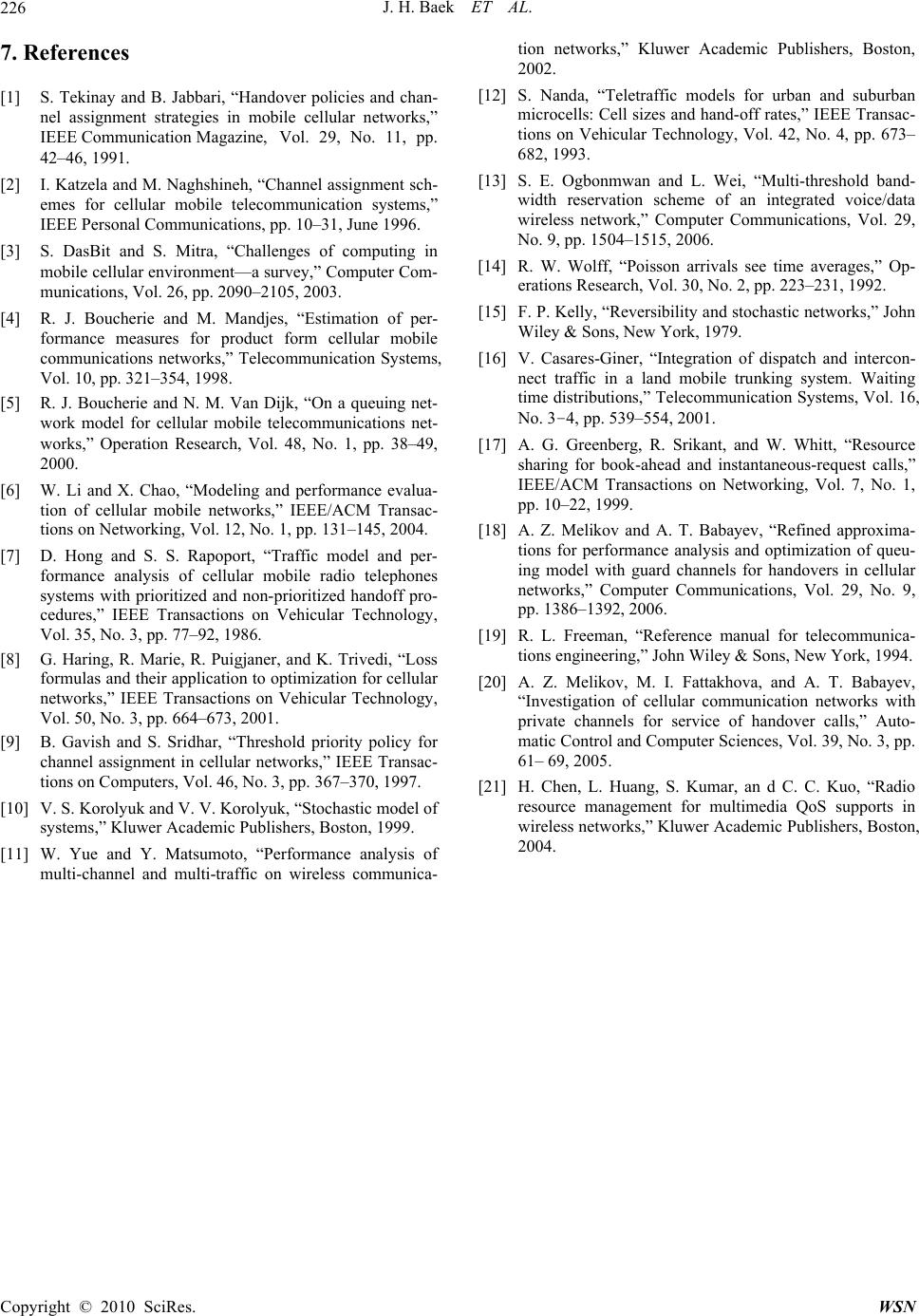 J. H. Baek ET AL. Copyright © 2010 SciRes. WSN 226 7. References [1] S. Tekinay and B. Jabbari, “Handover policies and chan- nel assignment strategies in mobile cellular networks,” IEEE Communication Magazine, Vol. 29, No. 11, pp. 42–46, 1991. [2] I. Katzela and M. Naghshineh, “Channel assignment sch- emes for cellular mobile telecommunication systems,” IEEE Personal Communications, pp. 10–31, June 1996. [3] S. DasBit and S. Mitra, “Challenges of computing in mobile cellular environment—a survey,” Computer Com- munications, Vol. 26, pp. 2090–2105, 2003. [4] R. J. Boucherie and M. Mandjes, “Estimation of per- formance measures for product form cellular mobile communications networks,” Telecommunication Systems, Vol. 10, pp. 321–354, 1998. [5] R. J. Boucherie and N. M. Van Dijk, “On a queuing net- work model for cellular mobile telecommunications net- works,” Operation Research, Vol. 48, No. 1, pp. 38–49, 2000. [6] W. Li and X. Chao, “Modeling and performance evalua- tion of cellular mobile networks,” IEEE/ACM Transac- tions on Networking, Vol. 12, No. 1, pp. 131–145, 2004. [7] D. Hong and S. S. Rapoport, “Traffic model and per- formance analysis of cellular mobile radio telephones systems with prioritized and non-prioritized handoff pro- cedures,” IEEE Transactions on Vehicular Technology, Vol. 35, No. 3, pp. 77–92, 1986. [8] G. Haring, R. Marie, R. Puigjaner, and K. Trivedi, “Loss formulas and their application to optimization for cellular networks,” IEEE Transactions on Vehicular Technology, Vol. 50, No. 3, pp. 664–673, 2001. [9] B. Gavish and S. Sridhar, “Threshold priority policy for channel assignment in cellular networks,” IEEE Transac- tions on Computers, Vol. 46, No. 3, pp. 367–370, 1997. [10] V. S. Korolyuk and V. V. Korolyuk, “Stochastic model of systems,” Kluwer Academic Publishers, Boston, 1999. [11] W. Yue and Y. Matsumoto, “Performance analysis of multi-channel and multi-traffic on wireless communica- tion networks,” Kluwer Academic Publishers, Boston, 2002. [12] S. Nanda, “Teletraffic models for urban and suburban microcells: Cell sizes and hand-off rates,” IEEE Transac- tions on Vehicular Technology, Vol. 42, No. 4, pp. 673– 682, 1993. [13] S. E. Ogbonmwan and L. Wei, “Multi-threshold band- width reservation scheme of an integrated voice/data wireless network,” Computer Communications, Vol. 29, No. 9, pp. 1504–1515, 2006. [14] R. W. Wolff, “Poisson arrivals see time averages,” Op- erations Research, Vol. 30, No. 2, pp. 223–231, 1992. [15] F. P. Kelly, “Reversibility and stochastic networks,” John Wiley & Sons, New York, 1979. [16] V. Casares-Giner, “Integration of dispatch and intercon- nect traffic in a land mobile trunking system. Waiting time distributions,” Telecommunication Systems, Vol. 16, No. 3–4, pp. 539–554, 2001. [17] A. G. Greenberg, R. Srikant, and W. Whitt, “Resource sharing for book-ahead and instantaneous-request calls,” IEEE/ACM Transactions on Networking, Vol. 7, No. 1, pp. 10–22, 1999. [18] A. Z. Melikov and A. T. Babayev, “Refined approxima- tions for performance analysis and optimization of queu- ing model with guard channels for handovers in cellular networks,” Computer Communications, Vol. 29, No. 9, pp. 1386–1392, 2006. [19] R. L. Freeman, “Reference manual for telecommunica- tions engineering,” John Wiley & Sons, New York, 1994. [20] A. Z. Melikov, M. I. Fattakhova, and A. T. Babayev, “Investigation of cellular communication networks with private channels for service of handover calls,” Auto- matic Control and Computer Sciences, Vol. 39, No. 3, pp. 61– 69, 2005. [21] H. Chen, L. Huang, S. Kumar, an d C. C. Kuo, “Radio resource management for multimedia QoS supports in wireless networks,” Kluwer Academic Publishers, Boston, 2004. |

